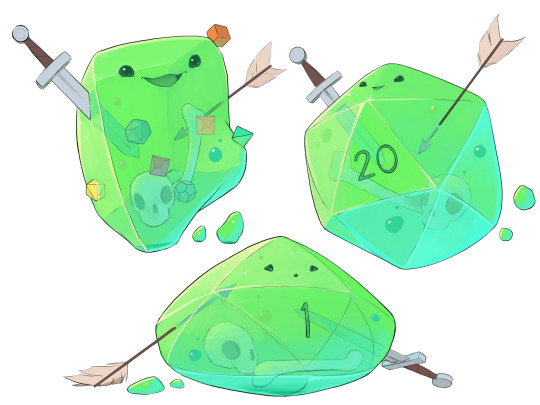All about TTRPGs ~ Creating Sprouting Tales, a card-based TTRPG
Don't wanna be here? Send us removal request.
Text
“For some time, Hollywood has marketed family entertainment according to a two-pronged strategy, with cute stuff and kinetic motion for the kids and sly pop-cultural references and tame double entendres for mom and dad. Miyazaki has no interest in such trickery, or in the alternative method, most successfully deployed in Pixar features like Finding Nemo, Toy Story 3 and Inside/Out, of blending silliness with sentimentality.”


“Most films made for children are flashy adventure-comedies. Structurally and tonally, they feel almost exactly like blockbusters made for adults, scrubbed of any potentially offensive material. They aren’t so much made for children as they’re made to be not not for children. It’s perhaps telling that the genre is generally called “Family,” rather than “Children’s.” The films are designed to be pleasing to a broad, age-diverse audience, but they’re not necessarily specially made for young minds.”
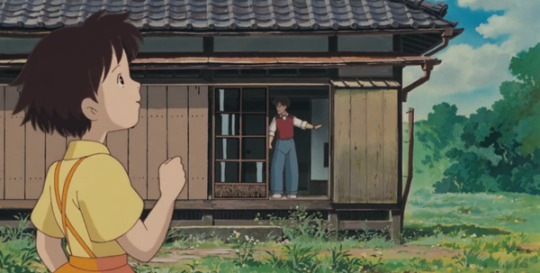
“My Neighbor Totoro, on the other hand, is a genuine children’s film, attuned to child psychology. Satsuki and Mei move and speak like children: they run and romp, giggle and yell. The sibling dynamic is sensitively rendered: Satsuki is eager to impress her parents but sometimes succumbs to silliness, while Mei is Satsuki’s shadow and echo (with an independent streak). But perhaps most uniquely, My Neighbor Totoro follows children’s goals and concerns. Its protagonists aren’t given a mission or a call to adventure - in the absence of a larger drama, they create their own, as children in stable environments do. They play.”
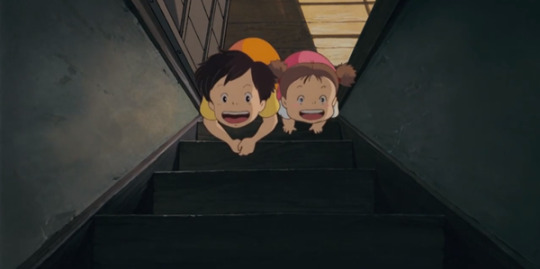
“Consider the sequence just before Mei first encounters Totoro. Satsuki has left for school, and Dad is working from home, so Mei dons a hat and a shoulder bag and tells her father that she’s “off to run some errands” - The film is hers for the next ten minutes, with very little dialogue. She’s seized by ideas, and then abandons them; her goals switch from moment to moment. First she wants to play “flower shop” with her dad, but then she becomes distracted by a pool full of tadpoles. Then, of course, she needs a bucket to catch tadpoles in - but the bucket has a hole in it. And on it goes, but we’re never bored, because Mei is never bored.”

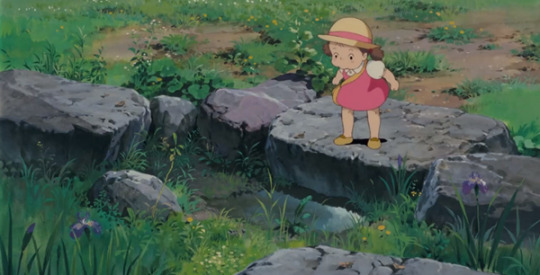
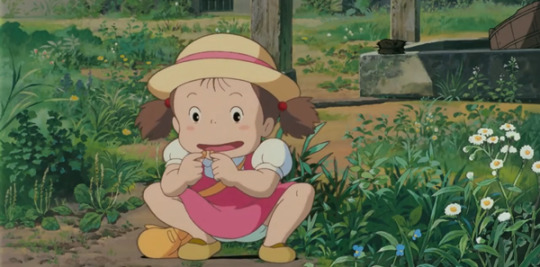

“[…] You can only ride a ride so many times before the thrill wears off. But a child can never exhaust the possibilities of a park or a neighborhood or a forest, and Totoro exists in this mode. The film is made up of travel and transit and exploration, set against lush, evocative landscapes that seem to extend far beyond the frame. We enter the film driving along a dirt road past houses and rice paddies; we follow Mei as she clambers through a thicket and into the forest; we walk home from school with the girls, ducking into a shrine to take shelter from the rain; we run past endless green fields with Satsuki as she searches for Mei. The psychic center of Totoro’s world is an impossibly giant camphor tree covered in moss. The girls climb over it, bow to it as a forest-guardian, and at one point fly high above it, with the help of Totoro. Much like Totoro himself, the tree is enormous and initially intimidating, but ultimately a source of shelter and inspiration.”

“My Neighbor Totoro has a story, but it’s the kind of story that a child might make up, or that a parent might tell as a bedtime story, prodded along by the refrain, “And then what happened?” This kind of whimsicality is actually baked into Miyazaki’s process: he begins animating his films before they’re fully written. Totoro has chase scenes and fantastical creatures, but these are flights of fancy rooted in a familiar world. A big part of being a kid is watching and waiting, and Miyazaki understands this. When Mei catches a glimpse of a small Totoro running under her house, she crouches down and stares into the gap, waiting. Miyazaki holds on this image: we wait with her. Magical things happen, but most of life happens in between those things—and there is a kind of gentle magic, for a child, in seeing those in-betweens brought to life truthfully on screen.”
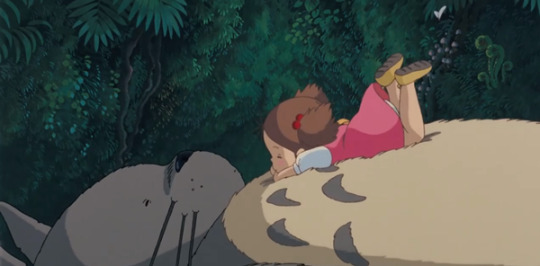
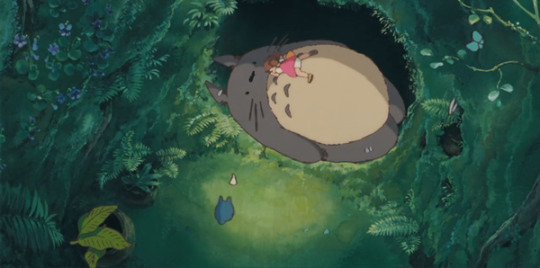
A.O. Scott and Lauren Wilford on “My Neighbor Totoro”, 2017.
90K notes
·
View notes
Text
Pro tip for world building: if you have an entity designed for the players to fight in combat, don't name it "pirate", "raider," "soldier" or something equally generic. And ESPECIALLY don't name their faction that!
It's much more characterful to give them a place or people that they come from.
Easy example: Fallout 3 vs Fallout: New Vegas
Fallout 3 has raiders, raiders, and more raiders.
New Vegas has Great Khans, Fiends, Powder Gangers, Jackals, Scorpions, Vipers, and Greasers.
All of the above are effectively "raiders" but New Vegas offers 7 different (or at least theoretically different) raider cultures with their own histories, while Fallout 3 has 1, maybe 0, raider cultures.
Even just naming these NPC groups will develop the world because it'll either make the players or YOU, the designer, ask questions about why they are named that.
In short: every NPC has a group they belong to, so at least name the groups.
PS: if you want more game design thoughts from me, my Patreon is here.
2K notes
·
View notes
Text
Think a lot of DMs would benefit from reading this short article
469 notes
·
View notes
Text
Magic 30 is for the fans!
366 notes
·
View notes
Text
New Jalopy Article is up!
A guide on pitching your games to the wonderful online retailers that keep our hobby connected and growing. Also features detailed interviews with...
Iglootree
Knave of Cups
Spear Witch
Monkey's Paw Games
Twenty Sided Store
ratti incantati
With questions such as...
What should NOT be included in a pitch?
How will you provide marketing and exposure to our products?
Can we pitch to multiple stores? Is that polite?
Where did you come up with the name for your store?
51 notes
·
View notes
Text
Sun and Moon Turn cards!


SproutingTales #TTRPG #indiettrpg #indie #gamedev #gamedesign
#sproutingtales#dnd#homebrew#tcg#ttrpg dev#ttrpg design#ttrpg community#ttrpg#gm advice#card game design#dnd5e#ccg#card games#card
0 notes
Text

It was a long Monday, so let's take this Tuesday to Rest
#card game design#ttrpg dev#ttrpg design#dnd5e#dnd#ccg#card games#card#ttrpg community#sproutingtales
0 notes
Text
Andor brings the heat



4 notes
·
View notes
Text

Have you ever seen another PC use an ability and really wish you could have that ability or a similar one? Entwine is for you!
0 notes
Text
Magic Boxes in TTRPGs
I don't like boxes
When I open a new TTRPG, I am greeted by a set of boxes. Little containers with all this fun stuff inside, Spells, Feats, Items, and Abilities. But there's a problem...
The walls of these boxes are well-defined and prescriptive. They tell me specifically when and how I use the stuff. If I want to go outside of that prescription, I need to talk to the GM about how I want to use the stuff and bend the walls of the box a little.
This works well for certain things where the desired use will fall inside the walls of the box 90% of the time. Things like a gun or honestly any other device that performs a function when I push a button.
However, this fails miserably when I think of a thing like a Spell, Ability, or Feat:
Yeah, so you can create a giant ball of fire and throw it at a target, but you actually don't have this other spell to create a smaller fire.
Creativity and the bending of rules are innately tied to MAGIC in almost all works of fiction but walled boxes don't support that.
Boxless (a.k.a. Notes and Rhythms)
In designing the magical elements of Sprouting Tales, I tried to keep that problem in mind and find an adequate solution.
To that end, I started with a couple of ideas:
Magic is innately tied to a creative enterprise
Players can build new magical effects
The pool of bricks they use to build new magical effects should be forever shifting
Magic is composed of a verb, something it does, and any number of nouns, subjects or objects of that verb
Where I landed
Magic in Sprouting Tales is innately tied to Music!
There are verbs or Rhythms
There are nouns or Notes
The Rhythms and Notes are presented on cards in play
Additional notes are presented by the environment (a torch could be fire, a river can be water, etc.)
Players create Songs by picking one Rhythm and any number of Notes
This method requires a good amount of GM moderation. Through playtesting I have developed a couple of arbitration guides: - Players can create magical effects that are weaker than another magical effect on a card in play (if a card can create a fireball, it can create a smaller fire) - Magical effects with duration are limited to 6 time(there is a note for Time to increase this) - Magical effects with range are limited to one area away (there is a note for Distance to increase this) - If a magical effect doesn't outright remove an obstacle, it still reduces the difficulty of the obstacle
Example:
A character creates a song using a Fly rhythm and a Stone note to make a nearby stone lift them up, to overcome a mountain. The mountain is too high for the fly rhythm to overcome, but they do fly up part way, and the difficulty of climbing over the obstacle is reduced.
#sproutingtales#ttrpg#indiettrpg#dnd#homebrew#ttrpg community#gm advice#magic#spells#tcg#lcg#ccg#card game design#card games#card game development company
3 notes
·
View notes
Text
New Card Design!

Start
Initially, I tried to make the cards very action-focused, with cards like:
attack
defend
move
debate
etc.
Using these action ideas I reached out to some artists to do some initial test works. At no fault of the artists, they did great work and I hope to still use most of them, the art ended up representing narrow uses of cards and coloring the game with a more action-heavy tone than I think it needed to be.
End
Ultimately, this led me to this different design space with a few core changes:
The cards are now named after specific character Qualities, instead of actions. This also allows for characters' personalities to shift and change over time in a more dynamic way.
Every card has an innate Source, see Scholar above, tied to it. When a player would gain a Scholar card, they'll pick from the remaining Scholar card pool (9). This limits the wall of text and information overload a player is faced with when initially creating and growing a character. I feel comfortable with this change because I'm confident more advanced GMs and Players will feel able to adjust these rules and create fully customized decks and characters.
Every card is now using plant or flower artwork to limit player associations with specific actions.
0 notes
Text
Long Time No See!
I took some time to compile all of my Homebrew D&D Subclasses and 125+ Magic items (organized by rarity, of course). Click the link and it’ll take you right to my Google Docs Thingy!
I’d be flattered if anyone out there wants copy/paste any of these ideas on their own blog or whatever! Like, if your blog is titled “D&D Homebrew Daily” or somesuch. My only request is that if you do, make sure to include a link to this blog post right here so that more folks will check out my crap!
(Also, feel free to reply to this post if y’all notice any mistakes I made. Like, if something seems Overpowered or Underpowered or too-vaguely-worded for a half-serious game of D&D)
250 notes
·
View notes
Photo
would love to use art like this for Sprouting Tales










The Songbook of Flowers (Jeannie Foord)
“Jeannie Foord was a Scottish artist known for her rare prints of flowers. The presentation of the stems and blooms extending beyond, or cropped within, the confines of the surrounding neat line reflects her familiarity with Japanese wood block prints. Each floral print is signed and dated within the plate with a chop mark, another reference to Japanese print makers and a device that was used by artisans of the artists of the Arts and Crafts and Art Nouveau movements. Foord’s botanicals inspired artists of the period who used her designs in their stained glass, fabric and woodworking.”
Sample Works:
1. Briar Rose
2. Gorse
3. Red Campion
4. Rest Harrow
5. Phlox
6. Lilies
7. Forsythia
8. Narcissus
9. Bluebell
10.Clematis
999 notes
·
View notes
Text
Things I am Unsatisfied with in TTRPGs
This is going to be a quick living list of things I am not satisfied with in TTRPGs I'll grow with time.
Some of these things will be things I don't necessarily dislike, but I do wish were better.
Some of these things will be things I might address in SproutingTales
1. High Consistency
Consistency just feels far too high for me. Time and time again a character is stuck playing one note. They progress to a more powerful character with time but they don't shift and change the way I would expect a living being to.
The onus is often on the player to breathe life into their character and make them shift with time in a way that feels right, but the mechanics don't often support these efforts.
2 notes
·
View notes

